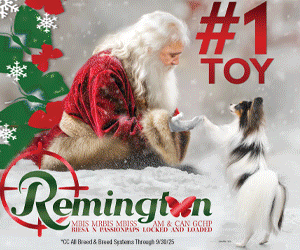From CC Vault · Rathmullan Kennels · The White Sisters Put Irish Wolfhounds on the Map
100 – May, 2016
by Amy Fernandez

Arthur Frederic Jones profiled many iconic kennels during his long tenure at the AKC Gazette. Possibly, he realized that he was documenting the end of an era. Either way, visiting those grand establishments was more than the daily grind. Along with the inevitable taste of luxury, the job provided an unadulterated dose of America’s hardcore addiction, that tantalizing peek into the lives of the rich and famous. Fascinating, historically relevant, and best of all, tons of those fabulous kennels were a stone’s throw from AKC’s Manhattan office. Greenwich, Conn., Westbury, L.I., Morris-town, N.J., Jones had a choice of irresistible invitations. Sooooo, there had to be something real special to justify packing off to Santa Fe, NM for editorial research.
Jones certainly considered the trip worthwhile as he rhapsodized in his intro for the subsequent May 1934 article. “Life’s infinite dimensions grow equally from the material and the spiritual…once the cities are left far behind, the cerulean cloak of the sky seems to reach down and press us closer to Nature itself. That, at least, was my thought when I recently had occasion to analyze the factors that have gone to make the Rathmullan Kennels at Santa Fe, New Mexico, one of the leading establishments of Irish Wolf-hounds in the United States.”
True, but you could prac-tically count them on one hand. Despite its ancient heritage, the Irish Wolfhound was then emerging from a rocky restart in Britain. Historians deemed it the miraculous resurrection of an ancient Celtic treasure or a half-baked revamp of bloodlines tracing back to Mastiff, Dane, Deerhound, and sundry other stuff. Still, pundits on both sides of the controversy agreed that Wolfhound type was coming together by 1897 when AKC took it on. Presumably, that signaled light at the end of the tunnel, except that the breed actually arrived here much earlier. Among others, George Washington had expressed colonial America’s urgent need for Irish wolfdogs, which were technically extinct in their homeland by that time.
By the time AKC recognized Irish Wolfhounds, the Longdog’s widespread popularity had drastically tilted the gene pool. Alma Starbuck, famed for her Ambleside bloodline, explained the situation by quoting a 1926 article by Mrs. Norwood Smith, breeder of Cragwood Wolfhounds and first president of the American club. “There are two distinct groups of Irish Wolfhounds in America. Both are registered yet they are different as Collie and Shetland Sheepdog.” Norwood called them “small rough-coated Greyhounds weighing 75-100 pounds” emphasizing that a discomfiting percentage of them were on the books at AKC because less stringent regulations of that era accommodated practical incentives to sell registered purebreds with papers. She wrote, “They are apparently produced in great numbers and find a ready market for $25 …they are bought by ranchers for coyote dogs, for which purpose they are well-suited…However, it happened these weird creatures are masquerading as Irish Wolfhounds…the time is not far distant when these little counterfeits will be crowded out.”
The joys of working with an unstable breed are self-explanatory. British breeders had been there, done that. Convincing them to send their carefully crafted stock into this quagmire was the reason for Mrs. Norwood’s militant diatribe. Ultimately, the breed’s future was at stake, and after 300 years of revisiting that drama, no one was keen for another round.
Imports from prized British bloodlines like Toyon, Sulhamstead, and Felixstowe slowly found their way into American kennels like Halcyon and Killybracken Farms. Starbuck’s 1963 book The Complete Irish Wolfhound traced this critical trade deal that got American Wolfhounds back on track. He wrote, “In these years history was constantly being born.” Needless to say, every import and its progeny were relentlessly monitored, and every American breeder involved with this project came with impeccable cre-dentials in other breeds. To put it mildly, IWCA members were extremely tightfisted with their breeding stock. They also realized that they were walking a fine line to maintain control of the breed’s direction while seeding the next generation of kennels. Regi-strations weren’t exactly spiking. In 1934 AKC registered 58 Wolfhounds, a whopping ten dog increase from the previous year.
Click here to read the complete article on page 100 of the May, 2016 Issue

Short URL: http://caninechronicle.com/?p=103254
Comments are closed












